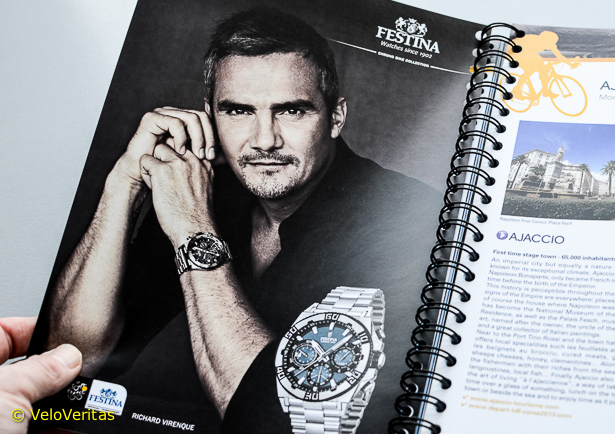We often hear about how the riders at the Tour de France study “the Roadbook” to familiarise themselves with the twists and turns in final kilometres of a particular stage, or to identify which day may be “the one” to go for, but what exactly does the Tour de France Roadbook contain, who uses it, and how useful is it, really?
Published by ASO each year a few weeks before the Prologue and in several languages, the Roadbook is also known as the race “Bible”.

Actually, it quickly becomes the indispensable tome for everyone working on the race, with a ton of information on the parcours, naturally, but also on the teams, mountain summits, the officials and their roles (handy when you need to know who to speak to to get your car accreditation upgraded if you want to follow a rider on a time trial stage, for example), race route signage, and so on. There’s even a guide to “good behaviour” for those folks working on the race.
The Roadbook isn’t unique to the Tour de France – all the major races publish their own version, but ASO’s Tour de France version is certainly the standard many others attempt to emulate.
It’s essentially in two parts, the “Introduction” and ‘The Stages”. The first section contains an overview of the main subjects for those working on the race with maps and guides, the second part describes each of the stages in more detail.


Whilst the best source of information on a day-to-day basis is the daily sports paper l’Équipe, – which shows each day who’s abandoned the race on which team, who won what stage and who has the lead in the various Classifications, as well as the paper’s ranking (marks out of 10) for the major players in the preceding stage – the Roadbook remains the essential reference for everyone.
Stage Details
Each stage description has a wealth of vital information whatever job you’re doing on the race.
There’s just a little bit of tourisme blurb about the start and finishing towns for each stage in the Roadbook. In the past when picking up our ‘creds’ we were given a bundle of books and literature, including a hardback Guide Touristique, which provided lots of information about every start and finish town, and points of interest in-between. And you thought Dave Harmon just knew a lot about France.

This is followed by a full-page detailed map showing the race route and the deviation, the off-race route that the team trucks should take to get to the finish without having to navigate those pesky mountain tops and spectators.
In our experience, this is the way a lot of journalists get to the finish too, and is the main reason why many of the words you read in magazines and newspapers are gleaned from the scribes watching the same TV pictures in the press room that you do at home – albeit they are able to chat to colleagues who may know interesting gossip and they can of course attend press conferences and interview riders and team staff as well.
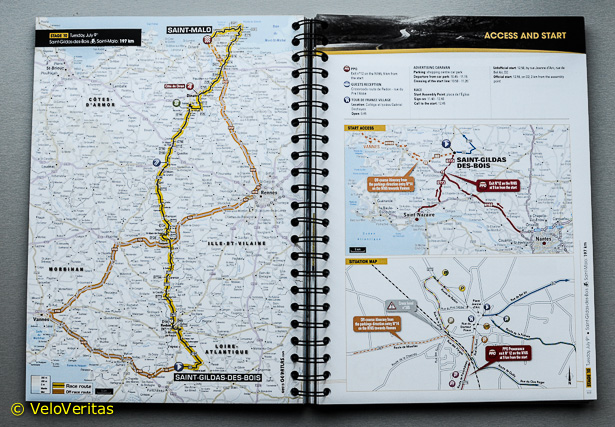
When we drive a stage along race route (our favourite way of getting from the start to the finish) we typically only see a handful of other press cars, usually from the radio or TV stations.
Often we’ll be passed by ASO Organisation, Skoda sponsors or other official cars ‘making good progress’, taking VIP guests for the trip of a lifetime along the closed roads at high speed, before stopping for a picnic lunch somewhere at the roadside, then waving cheerio as their guests board the helicopter for the journey to the finish. We’ll write more about what’s in the VIP picnic hamper in another article!
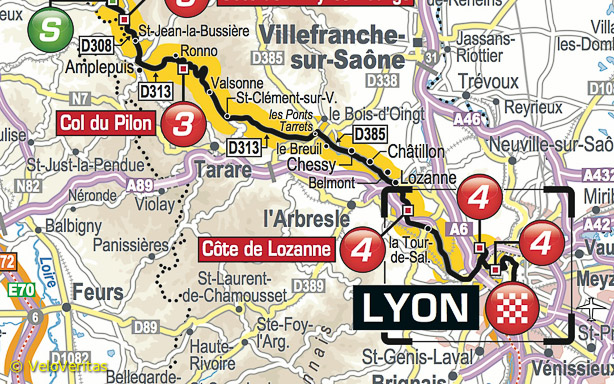
The map on the printed page is a useful high-level guide to which towns the parcours takes in, and when you use the Roadbook in .pdf format on the laptop you gain it’s true value – it’s tremendously helpful in identifying shortcuts and backroads to jump in front of the race – the map is in vector format and is scalable to a very detailed level. These days of course we just use the satnav for this kind of thing.
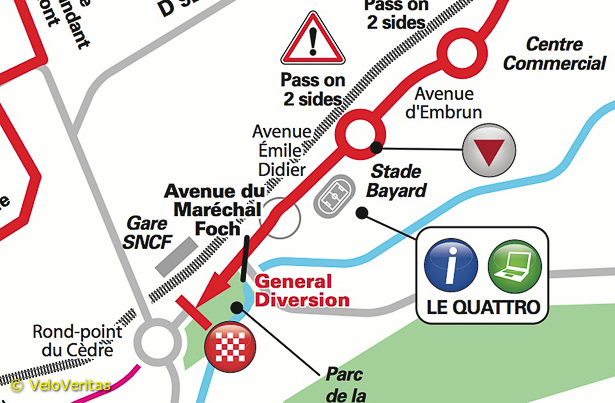
Accès et Départ
These sections are vital if we are intending to grab breakfast at the Village Départ, or park in the right location in order to set off to drive the route just in front of race. We’ll often aim to combine these two activities in the morning, usually because we’ll have arranged to interview some riders at their team buses or we’re on a mission to get a photo of a new prototype bike or wheel.

As you can imagine, there are hundreds of cars all trying to pick a good spot in the correct car parking area to allow a quick exit and more often than not it’s chaotic.
If we are going into the Village Départ it’s important to know the quickest way back to the car, for when we run out of time interviewing folk and drinking coffee and have to ‘bolt’ to the car to get away before the race rolls out. We’ll take you into the Village Départ this summer.
Profils du Jour
The Prolfil de l’Étape is the little saw-tooth diagram that you often see riders taping to their stem or top-tube. It’s some sort of barometer to how sore they will be tonight or how hard they will have to try to make the time cut.
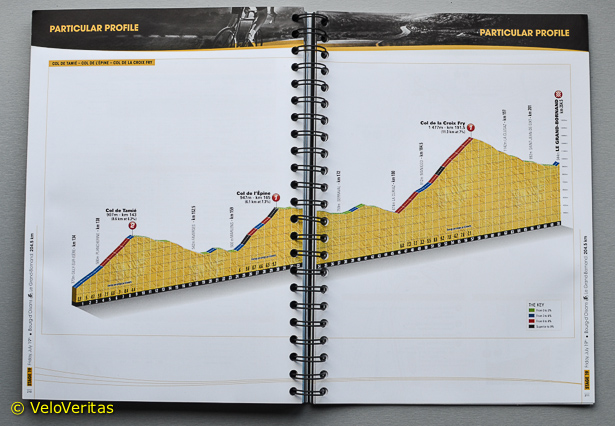
These days there are a couple of diagrams of every intermediate sprint as well, the Profil and Plan du Sprint Intermédiaire, showing the last few kilometres of run in, how flat or otherwise they are and what roundabouts need to be negotiated.
Itinéraire Horaire
This is the day’s schedule for the race, and includes three different plans depending upon the weather conditions or how tired the riders are; there’s timings for three different average speeds as well as the time the publicity caravan passes by.
This is all very handy when you’ve arranged to meet someone en route – or when you have been ordered off the course by an over-zealous gendarme who doesn’t understand that the accreditation colour scheme on your car stickers means you’re actually entitled to be driving where you are, but now you’re jinking around the side-roads parallel to the race route in order to find a different barrier with a different policeman who knows his job better (or cares less) and will let you back onto the course, far enough in front of the race coming through to not get into trouble again.

When we’re driving the race route and fall back less than 20 minutes in front of the leaders on the road, we’ll be encouraged to get a move on by the cops on the motorbikes. These guys are members of the Republican Guard; super-capable motorbike riders, firm and fair – but still gentlemen we don’t want to get on the wrong side of.
Hôtels des Équipes
In the good old days teams used to post a notice in the hotel lobby detailing which rooms the riders were in, so that everyone knew who was where. It seems odd that in this day and age, many teams still do this. You’re for the high-jump of course if you march straight up to a rider’s room – that would be very poor form, the best way of guaranteeing never getting an interview with that team again, and likely getting into trouble with ASO or the police as well.

Whilst getting to the actual hotel that a team are staying at is made easy, managing to secure an interview with a rider generally isn’t; it comes down to your relationship with the team’s press officer and/or who you are working for.
Having covered quite a few Tours and attended enough races we’re in the position now where we’re known to the team staff and have a good rapport with quite a lot of the riders so usually we can get to talk to who we want – but when they want. At least we know where they live for three weeks of the year.
Download the Roadbook
You can often find someone posting a copy of it on Scribd or similar document sharing sites, but it’s pretty big – last year it was in nine parts, each between 21Mb and 31Mb.
